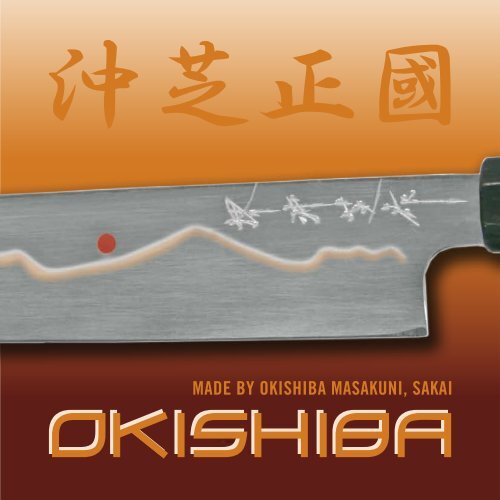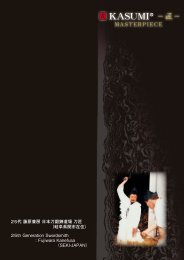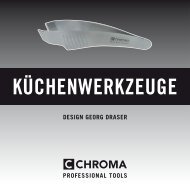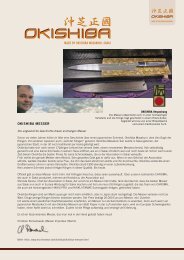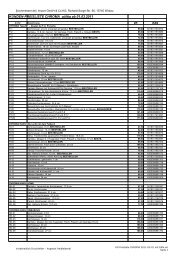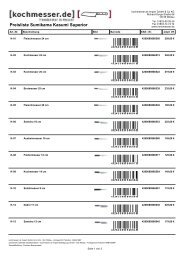MADE BY OKISHIBA MASAKUNI, SAKAI - Messer
MADE BY OKISHIBA MASAKUNI, SAKAI - Messer
MADE BY OKISHIBA MASAKUNI, SAKAI - Messer
- No tags were found...
You also want an ePaper? Increase the reach of your titles
YUMPU automatically turns print PDFs into web optimized ePapers that Google loves.
<strong>MADE</strong> <strong>BY</strong> <strong>OKISHIBA</strong> <strong>MASAKUNI</strong>, <strong>SAKAI</strong>Okishiba
<strong>OKISHIBA</strong> MESSERThe unbelievable tale of these unequaled knivesMany years ago, I would hear, every now and then, a storyabout a Japanese bladesmith, Okishiba Masakuni, the Van Goghof blades, also called “God of Blades” by other Japanese.Okishiba Masakuni San became the smith of smiths in Sakai,the Japanese city in which work is often traditionally done byhand, until he died a miserable death of a liver disease twentyyears ago, in 1990.Okishiba had become self-employed at an early age, after his17-year apprenticeship to his father, the renowned bladesmith,Okishiba Masatsugu, and had opened a small forge in his house,as was and today still is often customary in Sakai. Within notime, Okishiba was getting the best prices for his products,which he would sell to the Association in Sakai, a customarypractice at the time and one which is still often followed today.Okishiba was a lone wolf. No one, not even his wife, wasallowed into his forge. All too early, this brilliant masterbladesmith fell victim to alcoholism. He spent all his money on it.He worked in order to make money to buy alcohol. And yet, hisblades remained unmatched. No other bladesmith manufacturedknives of this quality. To date.Even today, stories are still told about Okishiba in the Sakaiknife community. When he would pick up his money at theAssociation, his wife would be waiting at the ready outside,wanting to frisk him and relieve him of the money needed to runthe household, etc. Okishiba would hide a good portion of hisearnings in his stockings, since his wife never searched them.This way, he would have enough for alcohol.Many three-star chefs are still working with Okishiba’s bladestoday, and they cost as much as 5 million yen. Used knives!The knives don’t depreciate in value if they are used correctly.New knives are unobtainable; Okishiba has been dead fortwenty years. The head of the Association in Sakai, Mr. ShinodaKeizou, still has a few blades in his warehouse that he gives uponrequest to the best chefs in Japan, but to no one else. Officially,he doesn't give these out any more. The response to requests isthat they are sold out.In the Japanese world of knives, the name ROMANOWSKIenjoys a very good reputation. I was the first to bring Japanesekitchen knives to Europe on a grand scale, and so became thefirst world-wide importer of such famous Japanese knife brandsas Global, Chroma, and Kasumi.We made contact with the Association through CHROMA, oursupplier, who also produces in Sakai. Shinoda Keizou, who neverhas a knife to spare under most circumstances, thought it agreat idea that the best knives from Sakai should advertise forSakai in Europe, and he has allocated to us nine (9) blades,perfected by the CHROMA team who also manufacture theoutstanding HAIKU PRO and HAIKU ITAMAE Suminagashiknives (see URL at HAIKU’s web page). We had to promise notto re-export the knives to Japan to turn a quick profit; Okishiba’sknives are in extreme demand in Japan.There are presently nine of Master Okishiba’s blades in thewest.One we will donate to a museum of Applied Arts. Others will goto other European countries as showpieces.And a small few can be purchased. The price amounts to30.000 US $ per knife, including accessories.However, we wish to warn all buyers. Even though a Japanesemaster chef can cut a piece of paper into four in the air with theOkishiba knife, a European would have trouble cutting an applewith it. He might break off a piece of the blade, which has beenground extremely thin. Sharpening the Okishiba knife alsorequires a lot of experience.A Japanese sushi apprentice undergoes a training period of atleast seven years. For the first three years, he does nothing otherthan clean the shop to show his humility, and grind his knife.
Daily, and for hours. At this point, however, he wouldn’t havean Okishiba, just a normal hand-made, good value Sakai qualityknife, such as the CHROMA HAIKU PRO. Out of sheer respect,he would not use the knife of a great master. Only in the courseof years, of decades, will he buy better knives. Also, he willreceive a good knife as a gift from his teacher at the end of hisapprenticeship. If he has been a good apprentice, it may even bevery old, perhaps one that his employer had once received as agift. In this way, many knives are passed down through thegenerations.Why are these Okishiba knives in such demand? They aresharper than others and keep their sharpness longer. It’s thatsimple.Why are these knives so expensive? Supply and demanddetermine the price. There are almost no Okishiba blades to behad on the market, and yet they are in heavy demand in Japan.To any interested Western buyer, I would recommendpurchasing an Okishiba knife only as a collector’s piece, not as aknife to work with, since its care is expensive and demands a lotof experience. It is a fascinating knife that you simply must getyour hands on!Christian Romanowski, Knife Importer (Berlin)
<strong>MADE</strong> <strong>BY</strong> <strong>OKISHIBA</strong> <strong>MASAKUNI</strong><strong>OKISHIBA</strong>KamagataUsuba24 cm<strong>OKISHIBA</strong>FugubikiFilleting knife27 cm<strong>OKISHIBA</strong>YanagibaSashimi30 cm<strong>OKISHIBA</strong>YanagibaSashimi33 cm<strong>OKISHIBA</strong>YanagibaSashimi36 cmOK-01 OK-02 OK-03 OK-04 OK-05
THE CERTIFICATEB2B1BA1B3Traditionalcraft logoBSakai Uchi HamonoCertification sealA2A1We hereby certify that this knife isone of a few precious existingknives that were crafted by therenowned blade-smith Mr. MasakuniOkishiba, crafted by means of thecharacteristic technique whichwas passed down from the ancienttime in Sakai.A2Sakai Touji, Izumiriki SeisakushoA3Company stamp(Izumiriki Seisakusho)A3B1Appointed a work of TRADITIONALCRAFT by the (Japanese) Ministry ofEconomy, Trade and IndustryB2REGISTRATION NUMBER:Each knife is examined and registeredbefore approval. Registration includestype of knife, length, manufacturer,examiner and examination date.B3<strong>SAKAI</strong> UCHI HAMONO(certified by) the Federation of SakaiCutlery Commerce and IndustryAssociations
[ kochmesser.de] [ ]www.kochmesser.de


